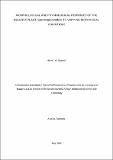Morphological and physiological responses of the invasive plant gutenbergia cordifolia to varying biophysical conditions
Abstract
This study assessed the effects of varying water stress levels on morphological and
physiological traits of an invasive plant Gutenbergia cordifolia (G. cordifolia) under field and
screen house conditions and the responses of these traits on performance G. cordifolia under
long and short rain seasons in the Ngorongoro Crater, Tanzania. The water stress level
assessment was conducted in the screen house at the Nelson Mandela African Institution of
Science and Technology (NM-AIST) following a completely randomized design (CRD) while
field assessment was conducted in Ngorongoro Conservation Area (NCA). While the
maximum and minimum plant heights in the screen house experiment were observed under
flood and drought water stress, respectively, the maximum and minimum root collar diameter
(RCD) were observed under moderate flood and drought water stress, respectively. Generally,
the number of leaves was highest under moderate flood stress and lowest under drought stress.
The largest and smallest leaf surface areas (LSA) were observed in flood and drought water
stress conditions, respectively. While a decrease in leaf chlorophyll was observed under
drought water stress, an increase in leaf anthocyanin levels was observed under flood stress. In
comparing field and screen house traits; both maximum G. cordifolia height and highest
number of leaves were observed under screen house. While the largest and smallest LSA were
observed in the field condition and screen house respectively, both the maximum root and shoot
fresh and dry weights were observed under field condition. Both leaf anthocyanin and
chlorophyll were higher under field compare to screen house. While both the maximum height
and the largest RCD were observed during long rain season the highest number of leaves per
plant was observed during short rain. Both highest root fresh and dry weight were observed
during long rain. The maximum leaf chlorophyll level was observed during short rain season
while the minimum was observed during long rain season. The findings from this study indicate
that the establishment and spread of G. cordifolia is likely to be favoured by projected East
African rainfall (2050-2100) as suggested by Platts et al. (2015) and inform conservation and
management authorities on how growth and performance is likely to be in the future under
changing climate and the need of integrating this information in its future management
strategies. The study further suggests that efforts to minimize impacts of an invasive G.
cordifolia in a changing climate must include a good understanding of G. cordifolia behaviour
under extreme events so as to prepare effective management strategies and actions.

